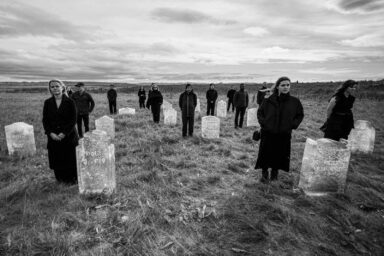A new study questions the narrative that dilution is the solution to pollution.
This story by Jackie Rocheleau originally appeared in Eos and is republished here as part of Covering Climate Now, a global journalism collaboration strengthening coverage of the climate story.
Wildfire season is getting longer and more severe. The fires send smoky gases and fine particles of burnt matter drifting through the atmosphere, and their harm can be felt by lungs miles away.
It’s plain that wildfire smoke is harmful, and studies have linked smoke inhalation to inflammation, cell death, and lung diseases, including asthma. But figuring out the connection between smoke inhalation and ill health is tricky — wildfire smoke comprises a complex mixture of particles and gases, and once in the atmosphere, photochemical reactions transform those components into different substances. But a research team from the University of Georgia might have a lead after testing how fresh and aged smoke differentially exerted their toxic effects.
Something Old and Something New
As wildfire smoke rises into the atmosphere, sunlight spurs chemical reactions that alter the smoke’s original components (primary organic aerosols) and create new ones, so-called secondary organic aerosols, over the course of hours to days. “That smoke is hanging out there for days and days and days, and it’s getting chemically cooked,” said Anthony Wexler, a professor and the director of the Air Quality Research Center at the University of California, Davis. Wexler was not involved in the new study. “And there are interesting questions there about how that’s changing the toxicity of this stuff.”
Once they enter human airways, the different aerosols likely take different routes through the body. Secondary organic aerosols are generally more oxygenated and soluble than primary ones. Primary organic aerosols are more readily taken up by fats, whereas secondary organic aerosols better dissolve in the bloodstream.
But when Rawad Saleh began researching the health effects of wildfire emissions at the University of Georgia’s College of Engineering, the associate professor was surprised by the dearth of information on how wildfire smoke toxicity changes as the smoke itself changes in the atmosphere.
To explore this research question, Saleh and his colleagues compared lung cells’ responses to fresh and aged smoke. They burned and tested three woods: pin oak, pignut hickory, and slash pine, all common fuels in a typical southeastern US wildfire. The researchers burned each wood just to a smolder inside an environmental chamber calibrated to mimic the light intensity, temperature, and humidity of a summer day at noon. To age the smoke, the researchers turned on UV lamps, allowing the smoke to bake in the “sun” for two hours.
The researchers extracted smoke particles from the chamber filters and dissolved them into a solution they then dropped into small compartments housing lung cells. The lung cells, specifically the bronchial epithelial cells that line the passageways into the lungs, faced both fresh and aged smoke from each wood.
Different Paths
After reacting with UV light in the environmental chamber, the aged smoke from each wood differed from fresh smoke in several key ways. Aged smoke had fewer heavy metals and aromatics but did have more heavily oxygenated compounds. This, the researchers thought, drove different toxicity mechanisms. The fresh smoke’s aromatics and metals homed in on the cellular powerhouse, mitochondria, disrupting the way cells store and use energy. But in the aged smoke, oxygenated compounds led to higher levels of cell death.
Revealing these different toxicity mechanisms is “incredibly important,” said Laura Van Winkle, a professor of respiratory toxicology at the University of California, Davis, who was not involved in the study.
The results, published in the journal Atmospheric Environment, implied that different mechanisms may trigger the same symptoms (like coughing and trouble breathing) when someone inhales fresh smoke compared with when someone inhales aged smoke particles hours to days later. “And because of that, the treatments that are effective for … that person could be different,” said Saleh. But this assessment is still speculative at this point, he cautioned.
Showing that components of fresh and aged smoke can be toxic in different ways challenges the idea that “dilution is the solution to pollution.”
“What they did was great, but no study does everything,” said Wexler. The researchers examined toxicity in only one type of lung cells, but lungs are made up of dozens of different cell types. Moreover, these cells don’t act in isolation but operate within bodily systems. The researchers also could not simulate the complexity of wildfire smoke and test all of its components. In wildfires, smoke is created from burning wood as well as from every other material in a fire’s path from soil, to animals, to cars. Smoke also includes gases, not just particles, which researchers did not analyze in this experiment.
But showing that some components of fresh and aged smoke can be toxic in different ways challenged the idea that “dilution is the solution to pollution,” said Van Winkle. “In California … secondary organic aerosol formation is a major source of air pollution,” she said.
The question then is whether breathing in those aerosols is as troubling as inhaling smoke from an active fire. “This [study] says yes, it could be.”



